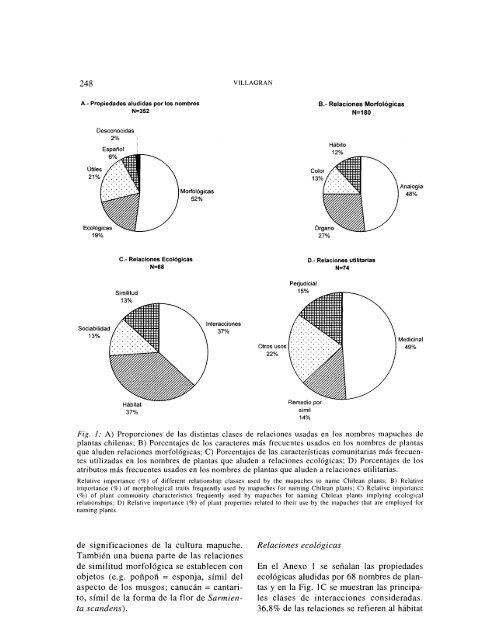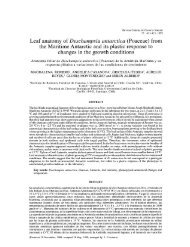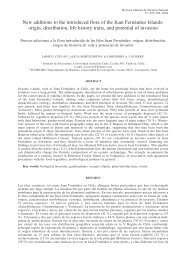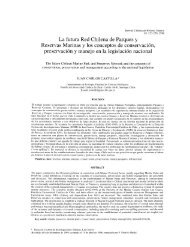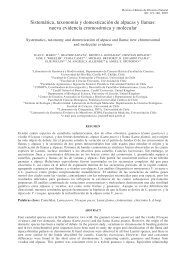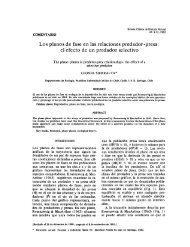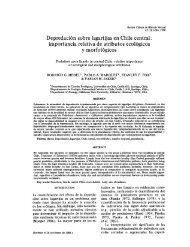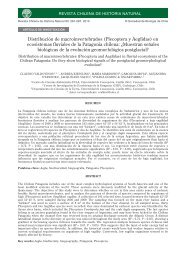Etnobotánica indígena de los bosques de Chile - Revista Chilena ...
Etnobotánica indígena de los bosques de Chile - Revista Chilena ...
Etnobotánica indígena de los bosques de Chile - Revista Chilena ...
Create successful ePaper yourself
Turn your PDF publications into a flip-book with our unique Google optimized e-Paper software.
248<br />
A.- Propieda<strong>de</strong>s por nombres<br />
N=352<br />
13%<br />
Desconocidas<br />
2%<br />
C.-<br />
13%<br />
Hábitat<br />
37%<br />
N=68<br />
Morfológicas<br />
52%<br />
Interacciones<br />
37%<br />
VILLAGRAN<br />
usos<br />
22%<br />
15%<br />
Remedio por<br />
si<br />
14%<br />
B.- Relaciones Moñológicas<br />
Hábito<br />
12%<br />
N=74<br />
N=180<br />
Analogía<br />
48%<br />
Medicinal<br />
49%<br />
Fig. 1: A) Proporciones <strong>de</strong> las distintas clases <strong>de</strong> relaciones usadas en <strong>los</strong> nombres mapuches <strong>de</strong><br />
plantas chilenas; B) Porcentajes <strong>de</strong> <strong>los</strong> caracteres más frecuentes usados en <strong>los</strong> nombres <strong>de</strong> plantas<br />
que alu<strong>de</strong>n relaciones morfológicas; C) Porcentajes <strong>de</strong> las características comunitarias más frecuentes<br />
utilizadas en <strong>los</strong> nombres <strong>de</strong> plantas que alu<strong>de</strong>n a relaciones ecológicas; D) Porcentajes <strong>de</strong> <strong>los</strong><br />
atributos más frecuentes usados en <strong>los</strong> nombres <strong>de</strong> plantas que alu<strong>de</strong>n a relaciones utilitarias.<br />
Relative importance (%) of different relationship classes used by the mapuches to name <strong>Chile</strong>an plants; B) Relative<br />
importance (%) of morphological traits frequently used by mapuches for naming <strong>Chile</strong>an plants; C) Relative importance<br />
(%) of plant community characteristics frequently used by mapuches for naming <strong>Chile</strong>an plants implying ecological<br />
relationships; D) Relative importance (%) of plant properties related to their use by the mapuches that are employed for<br />
naming plants.<br />
<strong>de</strong> significaciones <strong>de</strong> la cultura mapuche.<br />
También una buena parte <strong>de</strong> las relaciones<br />
<strong>de</strong> similitud morfológica se establecen con<br />
objetos (e.g. poñpoñ = esponja, símil <strong>de</strong>l<br />
aspecto <strong>de</strong> <strong>los</strong> musgos; canucán = cantarito,<br />
símil <strong>de</strong> la forma <strong>de</strong> la flor <strong>de</strong> Sarmienta<br />
scan<strong>de</strong>ns).<br />
Relaciones ecológicas<br />
En el Anexo 1 se señalan las propieda<strong>de</strong>s<br />
ecológicas aludidas por 68 nombres <strong>de</strong> plantas<br />
y en la Fig. 1 C se muestran las principales<br />
clases <strong>de</strong> interacciones consi<strong>de</strong>radas.<br />
36,8% <strong>de</strong> las relaciones se refieren al hábitat


